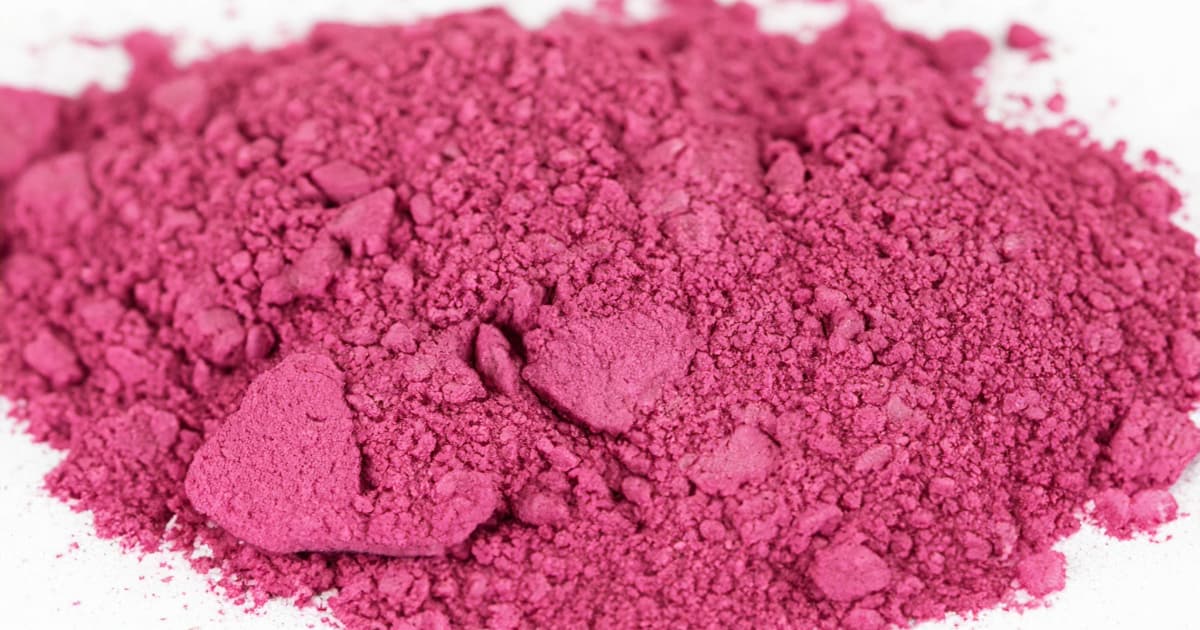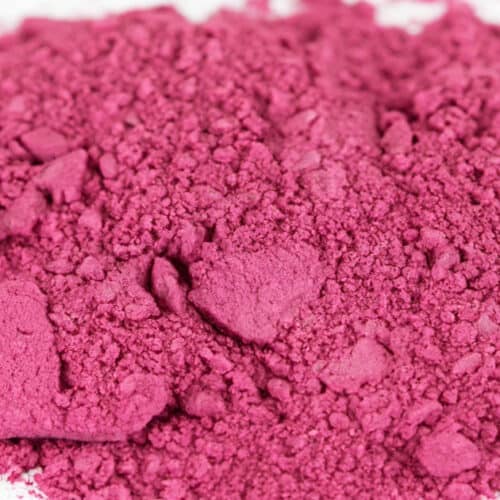Ube, also known as purple yam, is a vibrantly colored root vegetable that originates from Southeast Asia. It has a sweet, nutty flavor that makes it popular in Filipino desserts like ube ice cream, ube cake, and ube halaya.

Fresh ube can be difficult to find outside of Asian grocery stores. Luckily, you can easily make your own ube powder at home to use whenever a recipe calls for it. Having a batch of ube powder on hand gives you the ability to make ube desserts anytime without hunting down the fresh ingredient.
Making homemade ube powder only requires a few simple steps. You'll bake the ube, dehydrate it into chips, and then grind it into a fine powder. Read on for the full homemade ube powder recipe and tips for using it!
What You'll Need To Make Ube Powder
The two essential ingredients for ube powder are:
- Ube - Also called purple yam. Use fresh if possible but frozen works too.
- Oven or dehydrator - You'll need one of these to dehydrate the ube after cooking.
You'll also need:
- Baking sheet
- Parchment paper
- Potato peeler
- Fork or potato masher
- Blender or food processor
Optional equipment that's helpful but not essential:
- Mesh strainer or sieve
- Storage containers like jars or plastic bags
Step 1: Bake the Ube
The first step in making ube powder is to cook the ube. This step helps extend the shelf life while also making the ube easier to work with for peeling, mashing, and grinding later on.
Here's how to bake fresh ube:
- Preheat oven to 475°F (240°C).
- Wash and dry the ubes. Poke holes all over the skin with a fork.
- Place on a parchment lined baking sheet. No need to peel them before baking.
- Bake for 40-60 minutes until fork tender. The timing depends on their size.
For frozen ube, skip the oven step. You can go directly to peeling and mashing the thawed ube.
Allow the baked or thawed ube to cool enough to handle before moving to the next step.
Key Takeaway: Always cook fresh ube before dehydrating to improve safety and extend shelf life. Frozen ube can skip baking.
Step 2: Peel and Mash the Ube
Once the ube has cooled, you'll want to peel off the skin. It should slide off pretty easily after baking.
A potato peeler works best to remove the skin. Try to avoid wasting too much of the flesh underneath.
After peeling, place the ube flesh in a bowl and mash it thoroughly with a fork or potato masher. You want it mashed into a smooth, even paste.
Step 3: Dehydrate the Ube
Next, you'll dehydrate the mashed ube. This removes the moisture content so it can be ground into a shelf-stable powder.
You have two options for dehydrating it:
Oven Method
- Line a baking sheet with parchment paper.
- Spread the mashed ube in a thin, even layer on the sheet.
- Bake at the lowest temperature your oven allows, with the oven door propped open slightly. This allows moisture to escape.
- Dehydrate for 4-6 hours, checking frequently, until completely dried and brittle.
Dehydrator Method
- Spread the mashed ube in a thin layer on dehydrator trays lined with a non-stick sheet.
- Dehydrate at 113°F (45°C) for 8-12 hours until dried and brittle.
The ube is fully dehydrated when it snaps instead of bending. The timing varies based on the thickness of the layer.
Step 4: Grind Into a Powder
The final step is to grind the dehydrated ube pieces into a fine powder.
A blender, food processor, or electric coffee grinder all work well. You may need to grind it in small batches.
Process until it becomes a smooth, vibrant purple powder. Pass the powder through a mesh strainer or sieve to remove any remaining chunks.
And that's it - you now have homemade ube powder! It will keep for up to 6 months stored in an airtight container at room temperature. For maximum freshness, store in the freezer.
Key Takeaway: Fully dehydrate the ube until brittle before grinding to ensure it makes a fine powder rather than paste.
How to Use Homemade Ube Powder
Homemade ube powder can be used in both sweet and savory recipes. Here are some of the most popular ways to use it:
- Add to smoothies, ice cream, yogurt, oatmeal, etc. to turn them purple
- Use in baked goods like cakes, cookies, breads, and pastries
- Make ube halaya jam by reconstituting into a paste
- Add to lattes, hot chocolate, milkshakes, etc. for color and flavor
- Mix with vanilla or coconut extract to make ube flavoring
- Add to doughs like pancake, waffle, tortilla, and pizza dough
- Use as a natural purple food coloring substitute
- Make ube buttercream, mousse, curd, and other fillings/frostings
- Rehydrate into ube paste to use in Filipino kalamay and halo-halo desserts
- Add to waffle or pancake batter then top with ube halaya
- Swirl into ice cream, custard, or creme brulee
As you can see, the uses for ube powder are endless once you have a batch on hand!

Homemade Ube Powder
Ingredients
- 2 pounds fresh ube
- Parchment paper
- Potato peeler
- Food processor or blender
Instructions
- Preheat oven to 475°F. Wash ube and prick skin with a fork. Place on a parchment-lined baking sheet. Bake for 40-60 minutes until fork tender. Allow to cool.
- Once cool enough to handle, peel off the skin with a potato peeler. Try to avoid wasting too much flesh.
- Mash the peeled ube thoroughly with a fork or potato masher until smooth.
- Spread mashed ube in a thin layer on dehydrator trays lined with non-stick sheets. Dehydrate at 113°F for 8-12 hours until dried and brittle.
- Break ube chips into pieces and grind into a fine powder using a food processor or blender.
- Store homemade ube powder in an airtight container for up to 6 months at room temperature or 1 year in the freezer.
Frequently Asked Questions
Where can I buy fresh ube?
Fresh ube can be found in the produce section of Asian supermarkets. It may also be available from specialty online retailers. Make sure to use it within a few days for maximum freshness.
Can I use purple sweet potato instead of ube?
Yes, purple sweet potato can be used to make powder with a very similar taste and color to ube powder. The process is the same.
How long does homemade ube powder last?
Properly stored in an airtight container, ube powder will last 6 months at room temperature or up to 1 year in the freezer.
Why does my ube powder look brown?
If the ube wasn't dried properly before grinding, it can turn brown. Make sure the ube is fully dehydrated and brittle next time. Storing in the freezer can also help preserve the color.
Can ube powder be used as food coloring?
Yes, ube powder mixed with a bit of water makes a natural purple food coloring. Start with a small amount and add more as needed to achieve the desired shade.
What does ube taste like?
Ube has a sweet, earthy, nutty vanilla-like flavor. The taste is smooth and not overpowering.
How do you reconstitute ube powder into paste?
Mix 2-3 tablespoons of ube powder with 1/2 cup of water in a saucepan. Heat while stirring until it thickens into a smooth paste. Allow to cool before using in recipes.
Conclusion
Making your own ube powder is an easy DIY project with huge payoff. Having a stash of this vibrant purple powder allows you to create beautiful ube desserts anytime the craving strikes. Now that you know how to make it at home, you'll never struggle to find this elusive purple root again!
With just 4 simple steps - bake, peel, dehydrate, and grind - you can turn fresh ube into powder that will last for months. Use it to add a pop of color and flavor to both sweet and savory recipes. Ube powder is also perfect for crafting all kinds of Filipino dessert classics.
So don't wait for a specialty grocery trip to enjoy ube treats! Make a batch of ube powder this weekend and unleash your creativity with this versatile ingredient.

